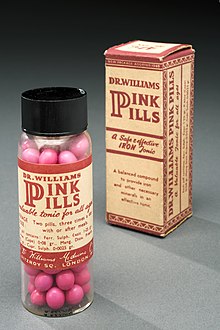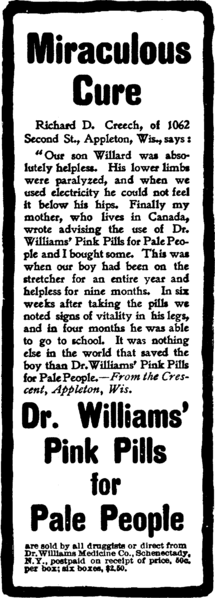

Dr. Williams' Pink Pills for Pale People was a late 19th to early 20th-century patent medicine containing ferrous sulfate and magnesium sulfate. It was produced by Dr. Williams Medicine Company, the trading arm of G. T. Fulford & Company. It was claimed to cure chorea, referenced frequently in newspaper headlines as "St. Vitus' Dance"; as well as "locomotor ataxia, partial paralyxia, seistica, neuralgia rheumatism, nervous headache, the after-effects of la grippe, palpitation of the heart, pale and sallow complexions, all forms of weakness in male or female."
The pills were available over-the-counter.
History
In 1890, G. T. Fulford & Company purchased the rights to produce Dr. Williams' Pink Pills for Pale People for $53.01 after encountering a pill prescribed by a local physician, William Jackson, and began marketing it through Dr. Williams Medicine Company. Reverend Enoch Hill of M.E. Church of Grand Junction in Iowa, endorsed the product in many 1900s advertisements, claiming that it energized him and cured his chronic headaches. Eventually, the product came to be advertised around the world in 82 countries, including its native Canada, the United States, and Europe. In the late 19th century, the pills were marketed in the UK by the American businessman John Morgan Richards.
The Pink Pills were widely used across the British Empire and, as the historian of Southeast Asia Mary Kilcline Cody puts it, "If the invulnerability magic of the sola topi, the spine pad and the cholera belt failed, Europeans could always rely on the Pink Pills to alleviate the pressures of bearing the white man's burden." The Pink Pills were not only marketed in Europe; tales of its "wonder" spread even to Egypt.
In 1890, a successful Canadian businessman with journalism experience by the name of John MacKenzie helped to publicize the product. In 1892, he was made manager of the medicine company, and held that position until his retirement in 1929. When George Taylor Fulford, Sr., the Canadian senator that founded G. T. Fulford & Company, died in 1905 in an automobile accident, George Taylor Fulford II became involved in the family business.
Today, the home of George Taylor Fulford, Sr. in Brockville, Ontario, Fulford Place, is a tourist attraction that showcases the success of patent medicine products. It was acquired by the Ontario Heritage Foundation in 1991. In 2001 they formally put a plaque outside his home with a brief biography.
Ingredients
Coated in pink-coloured sugar, an analysis of the pills conducted in 1909 for the British Medical Association revealed them to contain sulphate of iron, potassium carbonate, magnesia, powdered liquorice, and sugar. Approximately one third of the iron sulphate in the pills had oxidised in the sampling analysed, leading to the statement that the pills had been "very carelessly prepared". The formula went through several changes, and at one stage included the laxative aloe, the major ingredient of Beecham's Pills. The Pills were finally withdrawn from the market in the 1970s.
References
- Martin, Rebecca. Cool Things - Pink Pills for Pale People, Kansas Historical Society kansapedia, July 2002 (retrieved 12 July 2013)
- "Pink Pills for Pale People". blog.medfriendly.com. Retrieved 2018-08-11.
- "Biography – FULFORD, GEORGE TAYLOR – Volume XIII (1901-1910) – Dictionary of Canadian Biography". Retrieved 2018-08-11.
- "Pink Pills for Pale People - Kansapedia - Kansas Historical Society". www.kshs.org. Retrieved 2018-08-11.
- .George Fulford and Victorian Patent Medicine Men: Quack Mercenaries or Smilesian Entrepreneurs? (Lori Loeb, CBMH/BHCM, Volume 16: 1999, pp.125-45)
- Mary Kilcline Cody, 'A Paler Shade of White', in Jan van der Putten and Mary Kilcline Cody, eds, Lost Times and Untold Tales from the Malay World, NUS Press, 2009, pp.82-96
- "Dr. Williams' Pink Pills". The Egyptian Gazette. 6 October 1906.
- ^ "The Ontario Heritage Trust". Ontario Heritage Trust. Retrieved 2018-08-11.
- "The Ontario Heritage Trust". Ontario Heritage Trust. 2016-12-08. Retrieved 2020-09-15.
- Secret Remedies: What They Cost & What They Contain,British Medical Association, London 1909, pp170, 174-155.
- Popular Medicines: an illustrated history, Homan,Peter G.; Hudson, Briony ; Rowe, Raymond C., Pharmaceutical Press 2008.
- A page from the newspaper The Constitution, now known as The Atlanta Journal-Constitution.
- A page from the Kansas State Historical Society.
- An article from A Quad-Cities Century. Printers and publishers listed on the side.
- Mary Kilcline Cody, "A Paler Shade of White" in Lost Times and Untold Tales from the Malay World, NUS Press, 2009 p. 93
- Brockville, Ontario's website referring to the owner's home as a tourist attraction
- "Fulford Place", Matthew Quick
- A 1900s advertisement, hosted on the website of Rochdale, United Kingdom
- Mackenzie, Warren (December 2005). "A Brief MacKenzie Family History Synopsis" (PDF). Cabar Feidh Newsletter. Clan MacKenzie Society. p. 6. Archived (PDF) from the original on 3 March 2016. Retrieved 5 March 2020.
- a PDF file from the Ontario Heritage Foundation